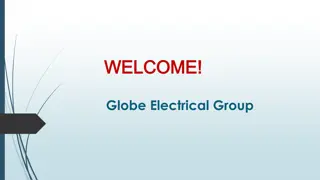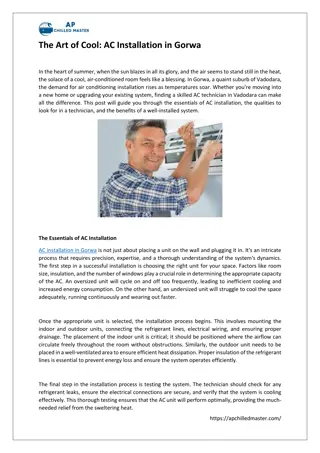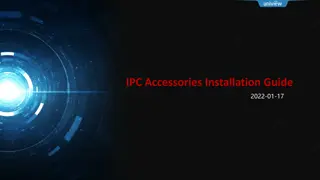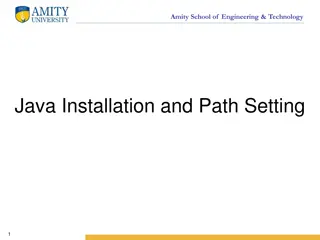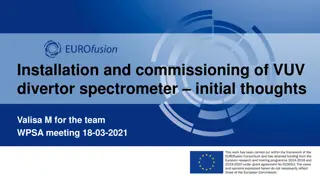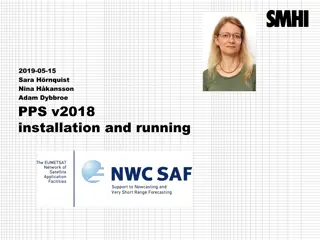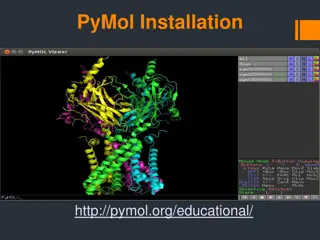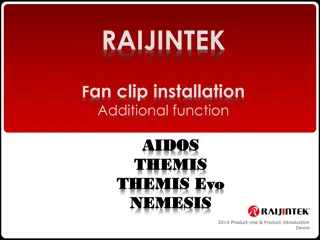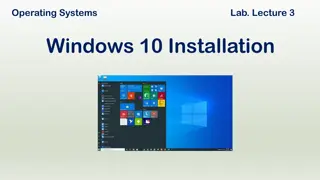
science and technology art installation
The installation combines science and technology to create an immersive experience that explores the interaction between humanity, innovation, and the natural world. Large-scale, abstract structures made of mirrored metal and transparent glass reflec
Download Presentation

Please find below an Image/Link to download the presentation.
The content on the website is provided AS IS for your information and personal use only. It may not be sold, licensed, or shared on other websites without obtaining consent from the author. If you encounter any issues during the download, it is possible that the publisher has removed the file from their server.
You are allowed to download the files provided on this website for personal or commercial use, subject to the condition that they are used lawfully. All files are the property of their respective owners.
The content on the website is provided AS IS for your information and personal use only. It may not be sold, licensed, or shared on other websites without obtaining consent from the author.
E N D
Presentation Transcript
Journal of Science and Technology ISSN: 2456-5660 Volume 7, Issue 10 (DECEMBER -2022) www.jst.org.in DOI:https://doi.org/10.46243/jst.2022.v7.i10.pp01- 06 Multi-Terminal Direct Current (DC) Networks for Grid Integration of Offshore Wind Farms: Operation and Power Flow Control Using Genetic Algorithms G HARIBABU1 ,P SHALLINI2 Assistant professor1,2 DEPARTMENT OF ELECTRICAL AND ELECTRONICS ENGINEERING P.B.R.VISVODAYA INSTITUTE OF TECHNOLOGY & SCIENCE S.P.S.R NELLORE DIST, A.P , INDIA , KAVALI-524201 To Cite this Article G HARIBABU ,P SHALLINI, Multi-Terminal Direct Current (DC) Networks for Grid Integration of Offshore Wind Farms: Operation and Power Flow Control Using Genetic Algorithms Journal of Science and Technology, Vol. 08, Issue 07,- DEC 2022, pp01-06 Article Info Received: 23-11-2022 Revised: 07-12-2022 Accepted: 16-12-2022 Published: 29-12-2022 Abstract: Offshore wind energy is expected to make a major contribution toward meeting Europe's renewable power ambitions. Because of the massive size and growing distance from shore of proposed future offshore wind farms, grid connectivity through a transnational DC network is very desired. This study looks at a nine-node DC grid that links the United Kingdom (UK), the Netherlands (NL), and Germany (DE). Distributed voltage control (DVC) is a unique approach for controlling power flow inside a multi-terminal DC grid that uses voltage-source converters. To reduce the amount of energy lost during transmission, this strategy uses an optimum power flow (OPF) solution. The paper's key contribution is the use of a genetic algorithm (GA) to resolve the OPF issue under the N1 security restriction. Following a summary of the primary DC network component models, the suggested control mechanism is shown in action through multiple case studies. Keywords: High-voltage direct current (HVDC) transmission; voltage-source converters; power electronics; DC networks; offshore wind energy; control theory; optimum power flow; genetic algorithms. Introduction The need for renewable energy sources to power our modern lives is growing for both social and economic reasons. However, the energy production from these sources is often modest per unit area [1]. Offshore wind farms will be an attractive option in terms of area, cost efficiency, and annual generated energy [2] when land for new renewable projects becomes limited. European offshore potential is projected to contribute for 16% of all renewable power generated in the continent by 2030 [3-5], with over 100 GW of offshore wind energy projects in production or planning stage. It is anticipated that offshore wind farms will soon have growing installed capacity as the power rating of current wind turbines continues to increase, with units as large as 10 MW already available and others under development [6]. In actuality, the London Array I offshore wind farm will have 630 MW of installed capacity when it is finally put into operation in April 2013 [7]. To effectively incorporate substantial volumes of offshore wind power into national energy networks, several European studies agree that a transnational offshore grid infrastructure is necessary [5,8]. In addition, international electrical trade might benefit from these transnational systems [9]. Since new offshore projects are often built farther from shore and with increasing installed capacity, DC transmission technology is likely to be used for the transnational grid. Transmission of electricity generated by huge, far-offshore wind farms to land through HVDC technology is the most cost-effective and environmentally friendly option [2]. However, several economic, legal, and technological concerns must be resolved [10] before a Multi-Terminal DC (MTDC) network, like the North Sea Transnational grid, can go from the drawing board to reality. Topology selection for HVDC converters [11 14], dc/dc converters [15 16], protection methods [17 19], dynamic stability concerns [20 22], and power-flow management techniques [23 26] are among the most crucial technical considerations. This article's goal is to show how a recently developed control approach, the distributed voltage control (DVC), and a genetic algorithm optimization may be used to run large MTDC networks with arbitrary optimum power flow [27]. The paper will
Journal of Science and Technology ISSN: 2456-5660 Volume 7, Issue 10 (DECEMBER -2022) www.jst.org.in DOI:https://doi.org/10.46243/jst.2022.v7.i10.pp01- 06 proceed as described below. The planned MTDC network model is first described in detail, including with its primary elements such wind farms and VSC-HVDC terminals. Second, the distributed voltage control technique is presented, and its operation is fully detailed. Next, we conduct in-depth numerical dynamic simulations of four distinct case studies that span over several MTDC network operational points. Finally, we discuss and draw implications from the case study analyses. Definition of Model The North Sea Transnational grid is a multi-terminal dc grid, and a simplified design with nine nodes has been selected to examine its control. Located in the southern North Sea, this topology accounts for a little slice of the potential future grid. As can be seen in Figure 1, it includes nodes that link to the United Kingdom (UK), the Netherlands (NL), and Germany (DE). Figure 1. Topology of the modelled MTDC grid Each country has its own offshore wind farm (the red dots in Figure 1) named UK1, NL1 and DE1. The black lines represent a pair of HVDC transmission cables and the intermediate nodes N4, N5 and N6 are cable T- joints. The wind farms size and location are derived by clustering the main offshore wind farms in the North Sea southern part; it includes wind farms in construction and planning phase. The nominal power of each wind farm is 1 GW (see Figure 2). The wind farms, as well as the ac networks, are connected to the MTDC grid through a single voltage-source converter (VSC) station. The ratings of all six VSC stations are chosen equal to 1 GW to make it possible to transport all wind power to the country that owns the wind farm. Trading offshore wind or onshore generated power is possible via line3 and line6, as shown in Figure 1, up to the VSC stations capacity. Table 1 gives the dc transmission length of each cable whereas other MTDC system parameters are given in Table 2. Figure 2. Components of the modelled MTDC grid (DE nodes). Table 1. MTDC network lines
Journal of Science and Technology ISSN: 2456-5660 Volume 7, Issue 10 (DECEMBER -2022) www.jst.org.in DOI:https://doi.org/10.46243/jst.2022.v7.i10.pp01- 06 Table 2. MTDC network parameters. MTDC Control Description Controlling the direct voltage inside a MTDC transmission system is equivalent to controlling the frequency in ac networks. A well-controlled direct voltage on a HVDC transmission network means the power is balanced amongst all nodes [38]. Usually, the control of point-to-point HVDC transmission systems is arranged as follows: one terminal controls the dc network voltage, whereas the other operates in current or power regulation mode. This control philosophy of having only one converter controlling the direct voltage can also be extended to MTDC networks, as in the voltage margin method [25,39,40] However, as the MTDC network grows in size and complexity, having only one terminal responsible for voltage regulation makes it increasingly difficult to guarantee the power balance in the network. Hence, for large MTDC networks, it is not recommended to control the direct voltage at a sole terminal. 3.1. The Distributed Voltage Control Method A more suitable control strategy is to have several terminals responsible for controlling the direct voltage inside the MTDC network. This increases reliability by adding redundancy and provides the possibility to control the dc power flow. The distributed voltage control (DVC) method assigns each dc-voltage- controlling VSC terminal with a specific voltage set-point [27]. In this way, the MTDC network voltage control is distributed amongst several nodes and any feasible load-flow scenario can be accomplished. In addition, no single converter assumes alone the responsibility of balancing the power inside the transmission system. Figure 7 illustrates how the DVC method works. Figure 3. Flow chart of the distributed voltage control method
Journal of Science and Technology ISSN: 2456-5660 Volume 7, Issue 10 (DECEMBER -2022) www.jst.org.in DOI:https://doi.org/10.46243/jst.2022.v7.i10.pp01- 06 The power generated at the OWFs is initially sent to the distributed voltage controller. To get the initial solution for the OPF method, a distributed dc load flow algorithm is then executed. A genetic algorithm or the steepest gradient method are only two examples of optimization techniques that may be used to the OPF issue [27,41]. A third-party system operator (ISO) determines the requirements and fine-tunes the OPF algorithm's parameters [42]. The security of the OPF solution against N 1 attacks is next examined. At that node, the direct voltage at each GS-VSC is controlled by the OPF algorithm to a value determined by the algorithm. For the given power- flow scenario, the distributed DC load-flow algorithm performs N load-flow scenarios with one dc node faulty at a time to determine whether the MTDC network is N 1 safe. The direct voltage set points are ultimately sent to the GS-VSCs through the DVC. Examples of Use Four case studies have been chosen to investigate the performance and potential of the distributed voltage control approach in maintaining the security and dependability of the dc network. Their goal is to demonstrate the efficacy of the DVC approach in regulating an MTDC grid for the integration of OWFs under conditions that are likely to arise, such as during start-up, normal operation, operation with wind curtailment, and operation under a contingency in a single ac network node. Case studies and their sub-cases are described in detail in Table 5. Case studies and their descriptions are included in Table 5. Results MATLAB/Simulink R was used to create the models described in Section 2. Table 5 details the case studies used in conjunction with which dynamic simulations were run. Each simulated case study lasts for a total of one hundred and fifty seconds. There are three primary stages involved in running dynamic simulations: First, a power series for the offshore wind farm is constructed as described in Section 2.2 (see Figure 3), and second, the evolutionary algorithm is used to solve for the best power flow. 3. The MTDC is simulated using the DVC based on the GA-generated direct voltage references; 4. The simulation uses a control cycle period of 5 s based on the OWF average power (see Sections 3.2-3.4); 5. Methods of Initiation (Sample Situation 1) The grid-side voltage-source converters raise the system direct voltage to 1 up, or 320 kV, during the MTDC network start-up operation. The findings of Case Study 1's simulation are shown in Figure 11. Each VSC terminal's active power injection (positive power) or absorption (negative power) into the MTDC network is shown in the top graph, while the MTDC voltage at each node is depicted in the bottom graph. The UK node is the first in the simulation to release its GS-VSC block at time t = 0.1 s. Within around 300 ms, the system voltage is increased from zero to 1 up thanks to the direct voltage controller's quick injection of roughly 0.5 up of power into the MTDC network. As can be seen in Figure 11, the system voltage does not begin at zero but rather at 0.1 up. Since Equation (4) determines the dc network current as the active power divided by the dc system voltage, this is done to prevent a division by zero.
Journal of Science and Technology ISSN: 2456-5660 Volume 7, Issue 10 (DECEMBER -2022) www.jst.org.in DOI:https://doi.org/10.46243/jst.2022.v7.i10.pp01- 06 Figure 5. Results from Case Study 1: MTDC Start-up The other nodes, with the exception of the German GS-VSC, are unblocked 300 ms after the UK GS-VSC was unlocked. The OWFs use some power at start-up, increasing the transient for the Dutch onshore node compared to the UK GS-VSC. At t = 0.6 s, the blockage in the German GS-VSC is removed, and a quick transient occurs in the MTDC network, causing only small voltage fluctuations in the dc system. The findings of case study 1 show that the whole MTDC network start-up process may be completed in under a second. A kick-start like that may not even be necessary under regular conditions. The ability to quickly black-start the MTDC network may be helpful in clearing dc faults, since VSCs do not have the ability to block dc faults and the development of high-power high-current dc short-circuit breakers is still in its infancy. Conclusions High-voltage multi-terminal DC networks are being developed because of the rising need for the integration of renewable electricity from far-flung energy sources such offshore wind generation. These networks have various benefits over conventional high-voltage AC networks. The VSC-HVDC technology is the most promising answer to that problem. But before such MTDC systems can be built, a number of legislative and technological hurdles must be cleared. In this study, we've outlined the fundamental elements of an MTDC network and provided dynamic models for them. To regulate the DC current, a unique control mechanism called distributed voltage control (DVC) strategy has been introduced. We looked at how the DVC tactic works in tandem with a genetic algorithm to reduce MTDC system losses as much as possible. In all, eight distinct case studies have been performed using MATLAB Simulink's dynamic simulation capabilities. The simulation results showed that the suggested control approach could regulate DC power flow reliably and securely. In addition, it References [1]. MacKay, D. Sustainable Energy Without the Hot Air, 3.5.2 ed.; UIT Cambridge Ltd.: Cambridge, UK, 2008; pp. 1 383. [2]. Besets, P.; Kling, W.L.; Hendriks, R.L.; Valatie, R. HVDC connection of offshore wind farms to the transmission system. IEEE Trans. Energy Convers. 2007, 22, 37 43. [3]. Pierid, J.; Axelson, U.; Eriksson, E.; Salomon son, D.; Bauer, P.; Czech, B. A wind farm electrical systems evaluation with EeFarm- II. Energies 2010, 3, 619 633. [4]. Vrana, T.; Torres-Olguin, R.; Liu, B.; Haileselassie, T. The North Sea Super Grid-a technical perspective. In Proceedings of 9th IET International Conference on AC and DC Power Transmission; London, UK, 19 21 October 2010; pp. 1 5. [5]. Van der Meer, A.; Teixeira Pinto, R.; Gibescu, M.; Bauer, P.; Pierik, J.; Nieuwenhout, F.; Hendriks, R.; Kling, W.; van Kuik, G. Offshore Transnational Grids in Europe: The North Sea Transnational Grid Research Project in Relation to Other Research Initiatives. In Proceedings of 9th International Workshop on Large-Scale Integration of Wind Power; Quebec, Canada, 18 19 October 2010; pp. 1 8. [6]. Bang, D.J. Design of Transverse Flux Permanent Magnet Machines for Large Direct-Drive Wind Turbines. Ph.D. Thesis, Delft University of Technology, Delft, The Netherland, 2010. [7]. London Array The World s Largest Offshore Wind Farm. Available online: http://www.londonarray.com/2012/10/29/worlds- largest-offshore-wind-farm-generates-firstpower/ (accessed on 21 December 2012).
Journal of Science and Technology ISSN: 2456-5660 Volume 7, Issue 10 (DECEMBER -2022) www.jst.org.in DOI:https://doi.org/10.46243/jst.2022.v7.i10.pp01- 06 [8]. Decker, J.D.; Tambke, J.; Volker, J.; Michalowska-Knap, K. An offshore transmission grid for wind power integration: The European techno-economic study OffshoreGrid. In Proccedings of 2010 IEEE Power and Energy Society General Meeting, Minneapolis, MN, USA, 25 29 June 2010. [9]. Kling, W.; Hendriks, R.; den Boon, J.H. Advanced transmission solutions for offshore wind farms. in Proceedings of IEEE Power and Energy Society General Meeting, Pittsburgh, PA, USA, 20 24 July 2008. [10]. Roggenkamp, M.; Hendriks, R. Market and regulatory aspects of trans-national offshore electricity networks for wind power interconnection. Wind Energy 2010, 13, 483 491. [11]. Garces, A.; Molinas, M. A study of efficiency in a reduced matrix converter for offshore wind farms. IIEEE Trans. Ind. Electron. 2012, 59, 184 193. [12]. Blasco-Gimenez, R. Diode-Based HVdc link for the connection of large offshore wind farms. IEEE Trans. Energy Convers. 2011, 26, 615 626. [13]. Ludois, D.; Venkataramanan, G. An examination of AC/HVDC power circuits for interconnecting bulk wind generation with the electric grid. Energies 2010, 3, 1263 1289. [14]. Shao, S.J.; Agelidis, V.G. Review of DC system technologies for large scale integration of wind energy systems with electricity grids. Energies 2010, 3, 1303 1319. [15]. Denniston, N.; Massoud, A.M.; Ahmed, S.; Enjeti, P.N. Multiple-module high-gain high-voltage DC-DC transformers for offshore wind energy systems. IEEE Trans. Ind. Electron. 2011, 58, 1877 1886. [16]. Lopez, A.; Diez, R. Analysis and comparison of three topologies of the ladder multilevel DC/DC converter. IEEE Trans. Power Electron. 2012, 27, 3119 3127. [17]. De Kerf, K.; Srivastava, K.; Reza, M.; Bekaert, D.; Cole, S.; van Hertem, D.; Belmans, R. Waveletbased protection strategy for DC faults in multi-terminal VSC HVDC systems. IET Gener. Transm. Distrib. 2011, 5, 496 503. [18]. Tang, L.; Ooi, B. Protection of VSC-multi-terminal HVDC against DC faults. In Proceedings of IEEE 33rd Annual Power Electronics Specialists Conference (PESC 02), Cairns, Queensland, Australia, 23 27 June 2002; IEEE: New York, NY, USA, 2002; Volume 2, pp. 719 724. [19]. Candelaria, J.; Park, J. VSC-HVDC System Protection: A Review of Current Methods. In Proceedings of 2011 IEEE/PES, Power Systems Conference and Exposition (PSCE), Phoenix, AZ, USA, 20 23 March 2011; IEEE: New York, NY, USA, 2011; pp. 1 7. [20]. Glasdam, J.; Bak, C.L.; Hjerrild, J. Transient studies in large offshore wind farms employing detailed circuit breaker representation. Energies 2012, 5, 2214 2231.


